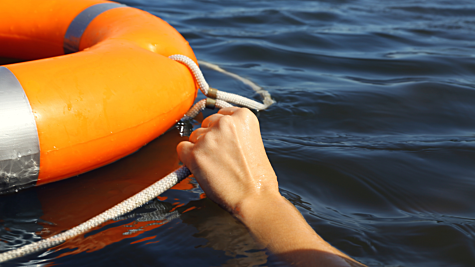Can a defibrillator be used on a victim rescued from water?

Fortunately defibrillators are now increasingly present in public places. Defibrillators are life-saving devices used to administer an electric shock, which restores the heart rhythm of people experiencing a sudden cardiac arrest. But what if a victim in a drowning accident needs CPR? Is it safe to use a defibrillator? In this blog, we will tell you all about using a defibrillator on a victim rescued from water.
Using a defibrillator on a victim rescued from water
A defibrillator can be used on a victim rescued from water, even when the victim is laying in a puddle of water, this is because the shock current runs between the electrodes. However, there are a few important actions required to safely resuscitate a victim rescued from water with a defibrillator:
- Safety first! Before using a defibrillator on the person rescued from the water, make sure you are in a safe environment. Make sure that you and any bystanders are not in any danger during the resuscitation process.
- Next it is important to dry the victim's chest and remove any damp clothing from the chest area. Make sure the chest of the wet person is dry before applying the electrodes of the defibrillator. Proper adhesion of the electrodes to the skin is important; a defibrillator cannot deliver an electric shock if the victim is too wet for the electrodes to adhere properly to the skin.
- After applying the electrodes, continue to follow the defibrillator's instructions. The defibrillator will guide you through the resuscitation process and tell you when to administer a shock (for a semi-automatic defibrillator) or when the device will deliver a shock (for a fully automatic defibrillator).
When to use a defibrillator on a person rescued from water?
Whether you should use a defibrillator on a person rescued from water depends upon the situation. When no breathing is detected in the victim, it is important to call the emergency services, start CPR and connect a defibrillator according to the instructions mentioned earlier. The defibrillator assesses whether a shock is necessary. If the victim is breathing, it is still necessary to seek medical attention. Drowning can have medical consequences, even when the victim appears to have regained consciousness.
A defibrillator is a valuable tool when resuscitating a victim rescued from water, but it is vital to follow the correct steps (such as drying the casualty) and follow the device's instructions carefully. In the event of a possible cardiac arrest, it is always important to act quickly, which is why we recommend taking a CPR and defibrillator training course. This will ensure that you will know how to react quickly and correctly in the case of an emergency, this can save a life!